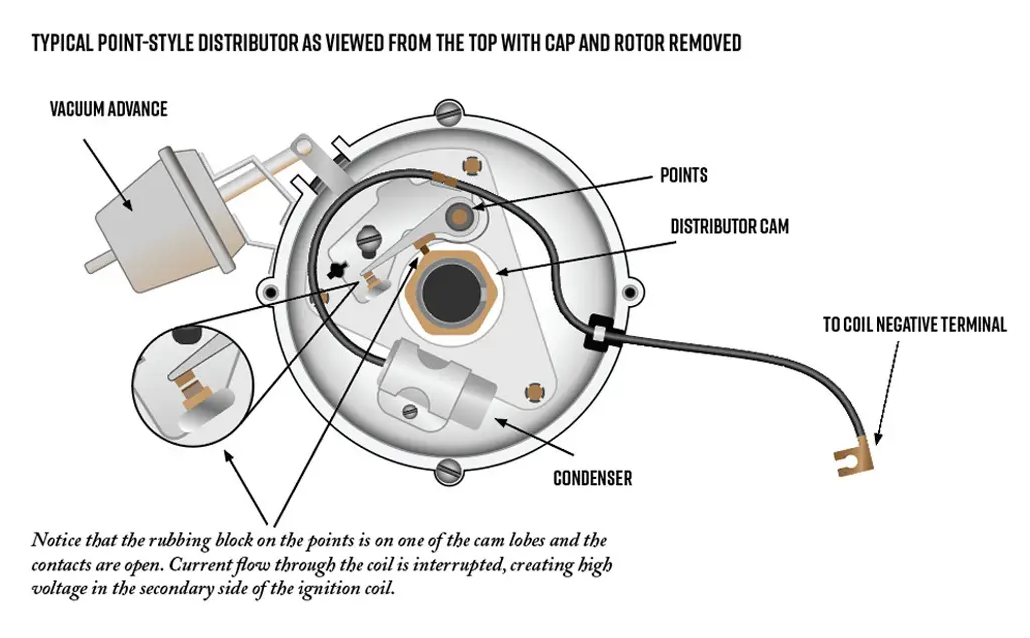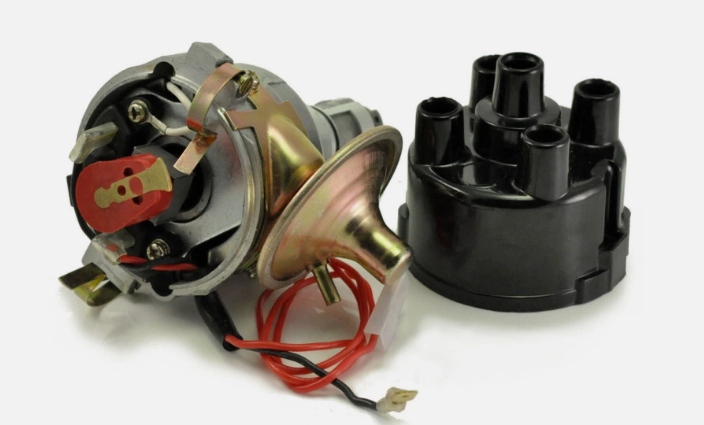
The age old question....which is best for your MGB?
Points & Condenser or Electronic Ignition?
Sorry to disappoint some......however I'm not about to write a write a full in depth book on the topic. However I will cover some of the common sense basics to explain the 'pro's and cons' of both ignition types. However, firstly you've got to understand what the purpose of points and condensers are....points gaps & dwell angle...ignition coils...spark plug gaps...and electronic ignition modules.
Points & Condenser - What are they....Well, they are nothing more than a circuit breaker / switch. When the points are closed they complete the circuit and allow the ignition coil to build up some charge / spark energy. When the points open the circuit breaks and the ignition coil releases a high voltage charge through the distributor rotor arm to the relevant HT lead, and onwards to a spark plug.....and of course the spark generated starts the combustion process.
Importance of points gap and resultant dwell angle - Needless to say if the points gap was massively too wide and never closes, the ignition coil doesn't get the chance to energise and build up a spark.
Conversely if the points gap is closed all the time, the circuit never breaks and the ignition coil never has the opportunity release the high voltage charge, and there's no spark.
So obviously, the points need to be set in such a way that they open the right amount to break the circuit, and close for the correct period of time to allow the ignition coil to build up enough spark energy. The amount of opening is done using a feeler gauge, at the point in time when the points are at their widest opening.....(see the image below). Below is a good example of a 6 cylinder application/distributor. (Note the central hexaganol drive in the centre and how the follower from the points is on the very edge of one of the hexagonal 'corners/edges'. This is when the points gap should be set). All this is done with the engine not running etc.

Points gap versus dwell angle - Let me firstly say that the points gap is set in order to achieve the right dwell angle. Hence achieving the correct dwell angle is the most important of the two.
On a 6 cylinder as per the above, lets for example say that 'the book' says set the points gap to 0.014 to 0.016". By design this should give you the desired dwell angle (period of time when the points are closed for) to then achieve the desired coil energy and spark quality. (A typical 6 cylinder spec is usually in the region of 35 deg of dwell +/- 3deg).
Lets say that you set your points to 0.016" and when running, your dwell meter say 26deg dwell. Well it means that 0.016" is actually too wide a gap. So redo the points gap, and try aim for a gap of 0.014" instead. Keep trying different points gaps until you are in the middle / upper end of the recommended dwell angle......4 cyl engine usually aim for as close to 60 deg as possible......6 cylinder maybe 33 or 34 deg dwell.....8 cylinder maybe 27 or 28 deg. (reset you ignition timing after achieving the desired dwell angle).
Please check the spec for your distributor make/model and your vehicles recommended dwell angle...

Spark plug Gaps - So now that your ignition coil has the correct period of time to build up the correct high voltage charge, it's time to think towards spark plug gaps. If the gap is absolutely huge..0.04"...0.06", the spark has no chance of jumping the gap, reliably and consistently........unless you have a very much uprated coil, which will develop massively more energy/voltage.
So......you need to ensure that the gaps on your spark plugs are set correctly, in accordance with your vehicle makers recommendation. Please do not rely on what the spark plugs were set at from the packet. NGK for example, they're often set to 0.034". If you're running a classic mini, MGB, Jaguar, Bentley etc etc....chances are that the recommended spark plug gap is somewhere between 0.022 and 0.025" and hence from the packet at 0.034" you're asking the spark to jump nearly 50% further than recommended.
If you happen to have stumbled upon this page........it's not finished yet, but I hope the above so far is useful and easy to understand.....thank you, Andrew
Electronic Ignition - what is it?
Well firstly there are many different types on the market, and they are all designed to do 2 principle tasks like points and condensers have to.....but instead using an electronic method of (a) Breaking the circuit and (b) controlling the dwell angle.
The most common utilise 'Hall Effect' during which a rotating magnet passes a sensor, causing the current through the senor to be interrupted and the coil to release spark energy....Powerspark, Petronix, Aldon Ignitors and.........Accuspark (not my favourite at all!!) etc.
Others may use circuitry within the distributor to stop/start the ignition coil charge cycles and electronically managed ignition advance curves....distributors such as 123, CSI and others..
There are of course other systems too!!
Compatibility of Ignition Coils
It is very important to use and ignition coil which is suitably matched to the trigger mechanism.
If you're on points and condenser the basics are either 12v or a ballast ignition coil. Your very very very basic rule of thumb for a 4 cylinder engine is that your 12v ignition coil will have a primary resistance around 3.0 ohms, and your ballast ignition coil will have approx 1.5 ohms. However they do vary so please check your vehicle spec.
For electronic ignition, a lot of the ignition coil decision is based around being compatible with the ignition module. Many use a 12v / 3.0 ohm....or a 1.5 ohm ballast coil....or even an ignition coil with a low primary resistance (0.6 to 1.1 ohm) such as the Lucas DLB198 type coil. Again, check compatibility with the actual system you are using...because you can often mistakenly use the wrong coil type, but they do tend to fail within within a really short period of time.
What do I recommend?
Be it 'points & condenser' or 'Electronic Ignition'......Use the best quality that you can afford. If going electronic ignition, the happy medium of 'price v quality' is often the high energy electronic ignition, with magnets embedded into an aluminium rotor, together with a high energy DLB198 type ignition coil...(not the Accuspark black plastic collar type).
Or dig deep into your pockets and buy either a 123 or CSI distributor.
Optimised electronic Ignition kits offered by AG Classic Car Tuning.
I have full electronic ignition packages available for MG's (Most -ve earth engines), Classic Minis and 1 or 2 others.
An ignition kit includes a full electronic ignition distributor (optimum curved for application), compatible ignition coil, low resistance HT leads and of course spark plugs....... Drop me a message and I can give you an approx price ??

